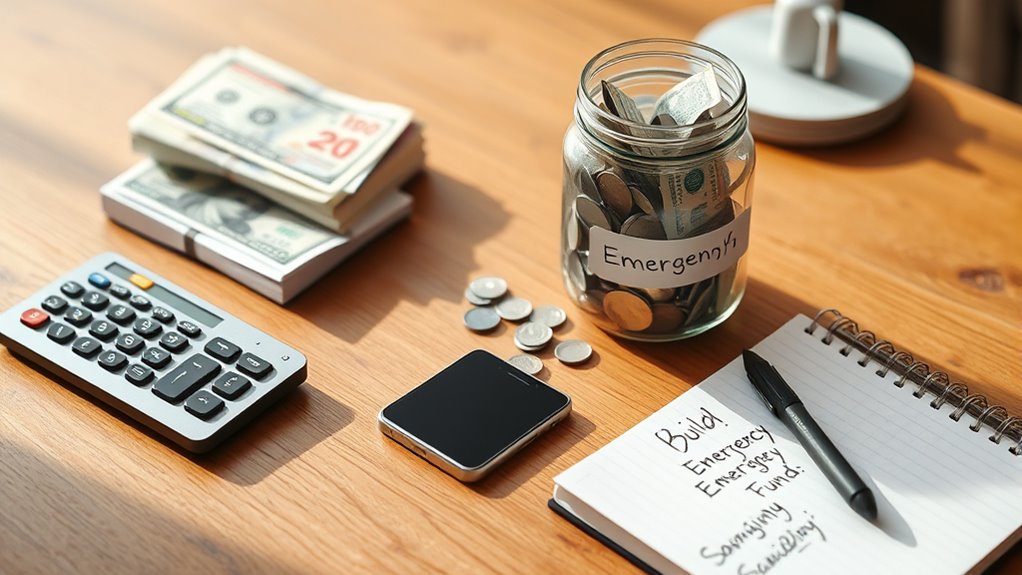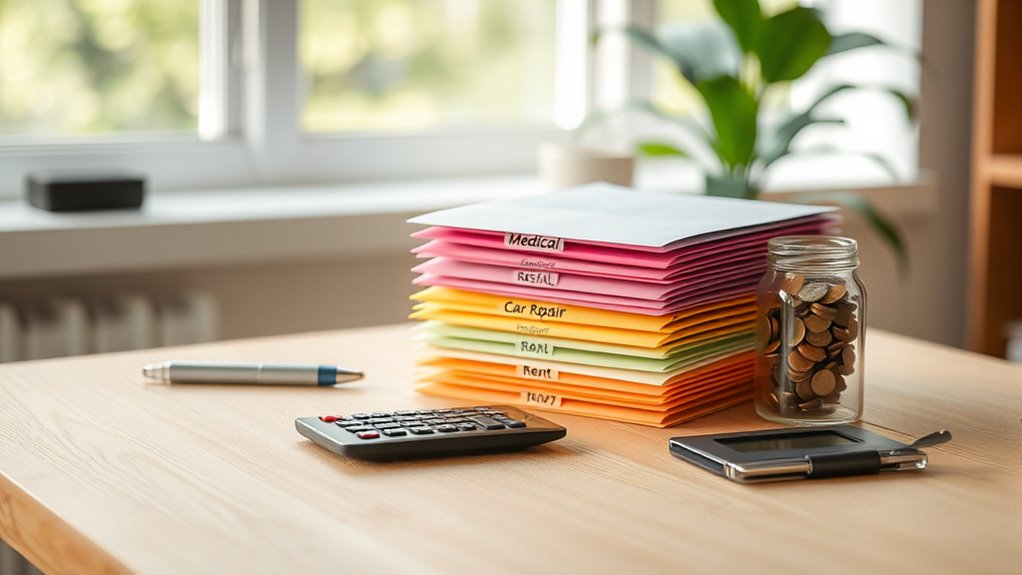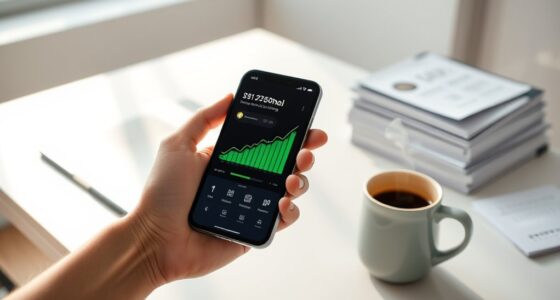To determine your emergency fund, aim to save three to six months of living expenses, depending on your job stability and personal situation. Use a separate, easily accessible account and set up automatic deposits to make saving effortless. Prioritize paying down high-interest debt to free up resources. Building your fund steadily reduces financial stress and prepares you for unexpected events. Keep in mind that the right amount varies for everyone, and mastering your strategy will help you stay protected long-term.
Key Takeaways
- Save 3 to 6 months of living expenses in a separate, easily accessible account.
- Determine your target based on job stability, bills, and lifestyle, adjusting for personal circumstances.
- Automate regular deposits to steadily build your emergency fund over time.
- Focus on high-yield savings or money market accounts for safety and quick access.
- Prioritize paying off high-interest debt to free resources for emergency savings growth.

Have you ever wondered what you’d do if an unexpected expense suddenly popped up? It can be a medical emergency, car repair, or sudden job loss—things that throw your finances into disarray. That’s where an emergency fund comes into play, serving as a financial safety net you can rely on during tough times. Building this fund requires careful planning, especially when it comes to your overall financial strategy. You need to balance your investment strategies with debt management to guarantee your emergency fund grows steadily without sacrificing other financial goals.
First, determine how much you need. Most experts recommend setting aside enough to cover three to six months’ worth of living expenses. But the exact amount depends on your personal situation—your job stability, monthly bills, and lifestyle. If you work in a volatile industry or are self-employed, aiming for six months might give you more peace of mind. On the other hand, if your job is secure and your expenses are predictable, three months may suffice. Once you have a target in mind, create a dedicated savings account that’s separate from your regular checking account. Automate deposits into this account, making saving effortless and consistent. Even small, regular contributions add up over time, gradually building your safety net.
When it comes to growing your emergency fund, your investment strategies should prioritize safety and liquidity. You want access to your money quickly without risking significant losses. High-yield savings accounts or money market accounts are ideal because they offer better interest rates than standard savings accounts while remaining easily accessible. Avoid tying your emergency fund up in long-term investments like stocks or bonds, which can fluctuate and delay your access when you need it most. Maintaining discipline with your savings habits is essential. Resist the temptation to dip into your emergency fund for non-emergencies, and revisit your savings plan periodically to guarantee you’re on track. Additionally, understanding liquidity and how it impacts your ability to access funds quickly is crucial in selecting the right savings vehicles for your emergency fund.
Balancing your emergency fund with other financial goals involves thoughtful debt management. Paying down high-interest debt should be a priority because the interest costs can negate any gains from your savings. Once you’ve reduced your debt, you can redirect more funds into your emergency savings. Having a healthy emergency fund also reduces financial stress, enabling you to make smarter choices about investments and long-term planning. By managing debt effectively, you free up resources to grow your emergency fund faster, while your investment strategies focus on building wealth over time.
Frequently Asked Questions
How Often Should I Review My Emergency Fund?
You should review your emergency fund at least every three to six months. Regular reviews help you stay aligned with your current financial situation and adjust for changes in your income or expenses. This practice supports your investment strategies and risk management efforts by ensuring you have enough savings to cover unexpected expenses. Keep an eye on market shifts or personal circumstances so your emergency fund remains effective and reliable.
Can I Use Retirement Savings for Emergencies?
Resist the urge to raid your retirement fund for emergencies. Using your retirement savings for an emergency withdrawal can lead to penalties, taxes, and long-term losses. Instead, prioritize building a dedicated emergency fund, which provides quick, penalty-free cash. Remember, your retirement is for future security, so keep it untouched during crises. Focus on feasible, financial fixes first — your future self will thank you!
What Are the Best Places to Keep My Emergency Fund?
You should keep your emergency fund in accessible investment options like a high-yield savings account or a money market fund. These options offer quick access when emergencies strike, addressing accessibility concerns. Avoid tying up your funds in long-term investments like stocks or retirement accounts, which can be less liquid. Prioritize safety and liquidity to make certain you can access your emergency money immediately when needed, without penalties or delays.
How Do I Start if I Have Debt?
Did you know that nearly 70% of Americans live paycheck to paycheck? To start, prioritize debt repayment while also building small savings. Use simple savings strategies like automating a tiny amount each month, even if it’s just $10. Focus on paying off high-interest debt first, then gradually increase your savings. This approach helps you reduce debt faster and creates a foundation for your emergency fund.
Is It Okay to Have Multiple Emergency Funds?
Yes, it’s okay to have multiple emergency funds, especially if you want to cover different areas like healthcare, car repairs, or job loss. You should consider your overall fund allocation and prioritize high-risk areas first. Diversifying your emergency funds across various investment options can help manage liquidity and growth. Just guarantee each fund is accessible when needed and aligns with your financial goals for better security.
Conclusion
Think of your emergency fund as a sturdy lifeboat, ready to carry you through turbulent waters. By building it step by step, you’re anchoring your financial ship against unexpected storms. Just as a lighthouse guides sailors safely to shore, your fund provides stability and peace of mind when chaos strikes. Keep adding to it, and soon, you’ll have a reliable refuge, ensuring you’re prepared for life’s unpredictable waves.









